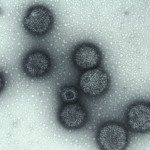Link to Pubmed [PMID] – 23576539
Link to DOI – 10.1128/JCM.00606-13
J Clin Microbiol 2013 Jun; 51(6): 1868-80
Populations of the food-borne pathogen Listeria monocytogenes are genetically structured into a small number of major clonal groups, some of which have been implicated in multiple outbreaks. The goal of this study was to develop and evaluate an optimized multilocus variable number of tandem repeat (VNTR) analysis (MLVA) subtyping scheme for strain discrimination and clonal group identification. We evaluated 18 VNTR loci and combined the 11 best ones into two multiplexed PCR assays (MLVA-11). A collection of 255 isolates representing the diversity of clonal groups within phylogenetic lineages I and II, including representatives of epidemic clones, were analyzed by MLVA-11, multilocus sequence typing (MLST), and pulsed-field gel electrophoresis (PFGE). MLVA-11 had less discriminatory power than PFGE, except for some clones, and was unable to distinguish some epidemiologically unrelated isolates. Yet it distinguished all major MLST clones and therefore constitutes a rapid method to identify epidemiologically relevant clonal groups. Given its high reproducibility and high throughput, MLVA represents a very attractive first-line screening method to alleviate the PFGE workload in outbreak investigations and listeriosis surveillance.




